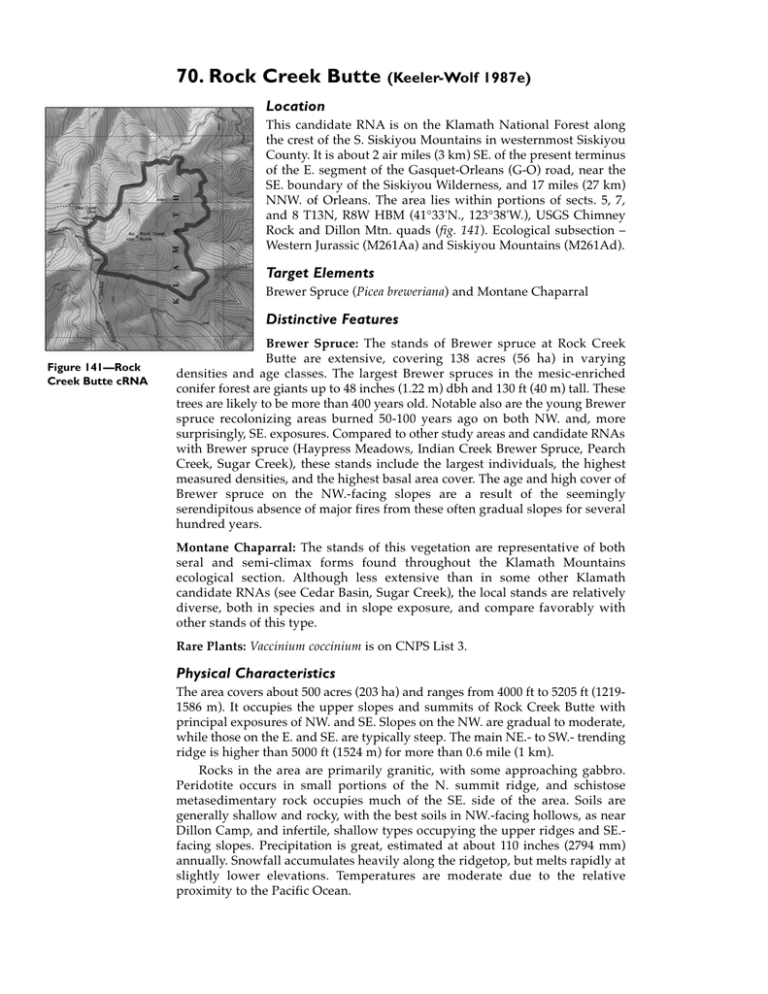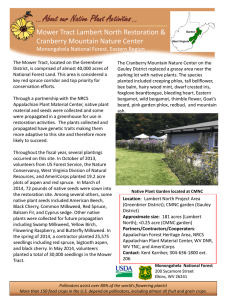70. Rock Creek Butte (Keeler-Wolf 1987e) Location
advertisement

70. Rock Creek Butte (Keeler-Wolf 1987e) Location This candidate RNA is on the Klamath National Forest along the crest of the S. Siskiyou Mountains in westernmost Siskiyou County. It is about 2 air miles (3 km) SE. of the present terminus of the E. segment of the Gasquet-Orleans (G-O) road, near the SE. boundary of the Siskiyou Wilderness, and 17 miles (27 km) NNW. of Orleans. The area lies within portions of sects. 5, 7, and 8 T13N, R8W HBM (41°33'N., 123°38'W.), USGS Chimney Rock and Dillon Mtn. quads (fig. 141). Ecological subsection – Western Jurassic (M261Aa) and Siskiyou Mountains (M261Ad). Target Elements Brewer Spruce (Picea breweriana) and Montane Chaparral Distinctive Features Figure 141—Rock Creek Butte cRNA Brewer Spruce: The stands of Brewer spruce at Rock Creek Butte are extensive, covering 138 acres (56 ha) in varying densities and age classes. The largest Brewer spruces in the mesic-enriched conifer forest are giants up to 48 inches (1.22 m) dbh and 130 ft (40 m) tall. These trees are likely to be more than 400 years old. Notable also are the young Brewer spruce recolonizing areas burned 50-100 years ago on both NW. and, more surprisingly, SE. exposures. Compared to other study areas and candidate RNAs with Brewer spruce (Haypress Meadows, Indian Creek Brewer Spruce, Pearch Creek, Sugar Creek), these stands include the largest individuals, the highest measured densities, and the highest basal area cover. The age and high cover of Brewer spruce on the NW.-facing slopes are a result of the seemingly serendipitous absence of major fires from these often gradual slopes for several hundred years. Montane Chaparral: The stands of this vegetation are representative of both seral and semi-climax forms found throughout the Klamath Mountains ecological section. Although less extensive than in some other Klamath candidate RNAs (see Cedar Basin, Sugar Creek), the local stands are relatively diverse, both in species and in slope exposure, and compare favorably with other stands of this type. Rare Plants: Vaccinium coccinium is on CNPS List 3. Physical Characteristics The area covers about 500 acres (203 ha) and ranges from 4000 ft to 5205 ft (12191586 m). It occupies the upper slopes and summits of Rock Creek Butte with principal exposures of NW. and SE. Slopes on the NW. are gradual to moderate, while those on the E. and SE. are typically steep. The main NE.- to SW.- trending ridge is higher than 5000 ft (1524 m) for more than 0.6 mile (1 km). Rocks in the area are primarily granitic, with some approaching gabbro. Peridotite occurs in small portions of the N. summit ridge, and schistose metasedimentary rock occupies much of the SE. side of the area. Soils are generally shallow and rocky, with the best soils in NW.-facing hollows, as near Dillon Camp, and infertile, shallow types occupying the upper ridges and SE.facing slopes. Precipitation is great, estimated at about 110 inches (2794 mm) annually. Snowfall accumulates heavily along the ridgetop, but melts rapidly at slightly lower elevations. Temperatures are moderate due to the relative proximity to the Pacific Ocean. Association Types Two parts of the enriched conifer forest were sampled: thirteen 100-m2 plots on the lower NW. slope and ten 100-m2 plots on the upper NW. slope. Mountain Chaparral (37510, 37520, 37542, 83210): 196 acres (79 ha). Two subtypes are represented. The most extensive one is successional, dominated by Quercus vaccinifolia. It covers about 175 acres (71 ha) SE. of the main ridge. The cover of dense 3- to 5-ft (1- to 1.5-m) shrubs is relatively continuous on moderate slopes and broken with small rocky openings on steeper slopes. Ceanothus velutinus, Arctostaphylos patula, and Garrya fremontii are also locally common. Most areas are being invaded by conifers (largely Douglas-fir and sugar pine) about 45-55 years old, dating back to the last major fire. On xeric S.-facing slopes, conifer invasion is slower as a result of more complete destruction of the former coniferous canopy. Here knobcone pine (Pinus attenuata) and white fir augment the other two conifers. Brewer spruce and noble fir (Abies procera) are also invading this type near the summit of Rock Creek Butte. Understory species are few and widely scattered. The second subtype is dominated by Arctostaphylos nevadensis and covers 21 acres (9 ha) on a few patches on the NW. side of the ridge. The substrate is generally ultramafic. Low shrubs of Quercus vaccinifolia, Q. sadleriana, Holodiscus discolor, and Prunus emarginata also occur. The more open and mesic nature of this phase allows a better development of understory herbs including Penstemon newberryi, P. parvulus, Lomatium macrocarpum, Sedum laxum ssp. heckneri, Koeleria macrantha, Eriogonum umbellatum, Selaginella wallacei, Erigeron bloomeri var. nudatus, Lewisia cotyledon, Carex brevipes, Cryptogramma acrostichoides, and Sitanion jubatum. This is a more stable phase than the Q. vaccinifolia subtype. The largest areas of A. nevadensis chaparral are not being actively invaded by conifers. However, smaller patches are associated with dense young forest dominated by noble fir and Brewer spruce and are successional. Siskiyou Enriched Conifer Forest (85410, 85310): 185 acres (75 ha). This forest occupies the NW. and NE. sides of the main ridge and is the densest, most productive, and most extensive of the forest associations in the area. The typical phase of this forest is moderately dense (930 trees/ha), dominated by large Douglas-fir (Pseudotsuga menziesii) up to 6 ft (1.8 m) dbh and 170 ft (52 m) tall. Associated with these relicts of the last major disturbance 200-400 years ago are the more abundant, but smaller species: noble fir and Brewer spruce. Both species are in nearly equal abundance as trees, but noble fir is more common as saplings and seedlings. Additional species include white fir (Abies concolor) and sugar pine (Pinus lambertiana) and occasional incense-cedar (Libocedrus decurrens) and western white pine (Pinus monticola). Total basal area cover of the forest is relatively high, averaging 185 m2/ha. Douglas-fir comprises 62 percent, noble fir 16 percent, and Brewer spruce 11 percent of that value. The understory of this forest has occasional small trees of Pacific dogwood (Cornus nuttallii), Acer glabrum var. torreyi, Pacific yew (Taxus brevifolia), and Salix scouleriana. The shrub layer is dense, dominated by Quercus sadleriana and Vaccinium membranaceum, with 11 other shrub taxa encountered in the sample. Herbs include 17 species with only a few such as Chimaphila umbellata and Xerophyllum tenax having more than a trace of cover. On W. and NE. exposures, the forest composition shifts to a higher Douglasfir dominance with fewer Brewer spruce and noble fir (this phase is called xeric enriched conifer). White fir, sugar pine, and incense-cedar increase in dominance. The shrub layer shifts to Quercus vaccinifolia dominance with some Arctostaphylos nevadensis, Garrya fremontii, and Symphoricarpos acutus. This more xeric forest has a scattering of such understory herbs as Xerophyllum tenax, Iris sp., Whipplea modesta, Bromus marginatus, and Hieracium albiflorum. The most mesic form of the enriched conifer forest occurs adjacent to moist seeps on NW. slopes, as near Dillon Camp. Douglas-fir, noble fir, and Brewer spruce co-occur with Port Orford-cedar (Chamaecyparis lawsoniana) in the canopy (fig. 142). The understory is dominated by Quercus sadleriana and Vaccinium membranaceum, but it also includes Vaccinium parvifolium and Alnus sinuata. Herbs are dense and diverse including Linnaea borealis, Achlys triphylla, Polystichum munitum, Clintonia uniflora, Trientalis latifolia, and Vancouveria hexandra. The highest-elevation form of this forest occurs just below the ridgeline on the NW.-facing slope. Douglas-fir is much less important than at lower elevations, with Brewer spruce and noble fir nearly equally dominant. The forest is relatively dense (1090 trees/ha) but has substantially lower basal area than the typical phase (112 m2/ha). The relatively small stature of the trees is a result of the harsh ridgetop environment and a large number of young trees. This upper ridge forest is structurally variable with several lobes of dense young trees dropping down from the ridge to interfinger with the more mature, open forest. These dense lobes originated from one or more fires over the past 100 years. Several virtually pure groves of Brewer spruce occur in steep or rocky areas, or both, along the ridges. These groves have been spared from fire for several hundred years. Reproduction is strongly dominated by noble fir, with Brewer spruce the second most important reproducer. The understory of this forest is poorly developed. Quercus sadleriana and Vaccinium membranaceum are dominant, but they account for less cover than at lower elevations. Douglas-Fir-Sugar Pine Forest (84110): 111 acres (50 ha). This association covers moderate to steep slopes on SE. exposures. It is an open forest with numerous mature trees, survivors of the last fire (around 1932). The canopy is dominated by Douglas-fir and sugar pine with discrete patches of Quercus vaccinifolia forming the principal understory. Ponderosa pine (Pinus ponderosa) and incense-cedar are more common at lower elevations. Rock Outcrop (no Holland equivalent): Although there are no large areas of continuous outcrops, many small rocky areas exist. These may be divided into mesic and xeric subtypes. Species of the mesic subtype (either on NW. exposures or shaded by trees) include Acer glabrum var. torreyi, Amelanchier pallida, Cheilanthes gracillima, Crypto-gramma acrostichoides, Heuchera macrantha, Holodiscus discolor, Polystichum imbricans, Sedum laxum, and Saxifraga fragarioides. The xeric subtype includes Luina hypoleuca, Penstemon newberryi ssp. berryi, Streptanthus tortuosus, and Eriogonum umbellatum. Spring and Seep (45400, 63500): Minimal acreage. Hydrophilic vegetation is restricted to small springy areas on the NW. side of the ridge. These may be either sunny or shaded. The shady type lies within the mesic phase of the enriched conifer forest and includes such species as Alnus sinuata, Cornus occidentalis, Rosa gymnocarpa, Paxistima myrsinites, Sorbus cascadensis, and Vaccinium parvifolium along with such herbs as Aquilegia formosa, Boykinia major, Habenaria saccata, Senecio triangularis, Tiarella unifoliata, and Tolmiea menziesii. On sunnier exposures species include Salix coulteri, S. jepsonii, S. leavigata, Agrostis exarata, Aruncus vulgaris, Carex cusickii, C. diandra, C. nervina, Epilobium adenocaulon, E. angustifolium, E. hornemannii, Galium aparine, Juncus effusus var. exiguus, and Petasites palmatus. Plant Diversity One hundred fifteen taxa of vascular plants are listed. Conflicting Impacts Although the area is bound on three sides by roads, these have little effect. A small dilapidated, radio-transmitting shack on the summit ridge is the only structure within the proposed boundaries. The long-established campsite at Dillon Camp is not heavily used, and associated woodcutting and litter are not strongly evident. Several years ago a lightning strike was actively suppressed by cutting a few stems of Douglas-fir near Dillon Camp. Management of the montane chaparral and Brewer spruce target elements will have divergent requirements: the former needs regular fire, and the latter requires protection from fire. Figure 142—Rock Creek Butte, mature enriched conifer forest near Dillon Camp with Brewer spruce (4 ft [1.2 m] dbh, right foreground), Port Orford-cedar, noble fir, white fir, and Douglas-fir in Rock Creek Butte cRNA. (1986)


